A Brief Review of the Impact of Neutron Irradiation Damage in Tungsten and Its Alloys
Abstract
1. Introduction
2. Microstructural Development
2.1. Voids
2.2. Dislocation Loops
2.3. Transmutation-Induced Precipitates
2.4. Defect Density Variation with Temperature and Dose
3. Transmutation
4. Irradiation Hardening
5. Summary and Future Outlook
Author Contributions
Funding
Data Availability Statement
Acknowledgments
Conflicts of Interest
References
- Federici, G.; Skinner, C.H.; Brooks, J.N.; Coad, J.P.; Grisolia, C.; Haasz, A.A.; Hassanein, A.; Philipps, V.; Pitcher, C.; Roth, J.; et al. Plasma-material interactions in current tokamaks and their implications for next step fusion reactors. Nucl. Fusion 2001, 41, 1967. [Google Scholar] [CrossRef]
- Wurster, S.; Baluc, N.; Battabyal, M.; Crosby, T.; Du, J.; García-Rosales, C.; Hasegawa, A.; Hoffmann, A.; Kimura, A.; Kurishita, H.; et al. Recent progress in R&D on tungsten alloys for divertor structural and plasma facing materials. J. Nucl. Mater. 2013, 442, S181–S189. [Google Scholar]
- Rieth, M.; Dudarev, S.L.; De Vicente, S.G.; Aktaa, J.; Ahlgren, T.; Antusch, S.; Armstrong, D.; Balden, M.; Baluc, N.; Barthe, M.-F.; et al. Recent progress in research on tungsten materials for nuclear fusion applications in Europe. J. Nucl. Mater. 2013, 432, 482–500. [Google Scholar] [CrossRef]
- Bolt, H.; Barabash, V.; Krauss, W.; Linke, J.; Neu, R.; Suzuki, S.; Yoshida, N.; Asdex Upgrade Team. Materials for the plasma-facing components of fusion reactors. J. Nucl. Mater. 2004, 329, 333–366. [Google Scholar] [CrossRef]
- Yang, X.; Qiu, W.; Chen, L.; Tang, J. Tungsten–potassium: A promising plasma-facing material. Tungsten 2019, 1, 141. [Google Scholar] [CrossRef]
- Arshad, K.; Ding, D.; Wang, J.; Yuan, Y.; Wang, Z.; Zhang, Y.; Zhou, Z.J.; Liu, X.; Lu, G.H. Surface cracking of tungsten-vanadium alloys under transient heat loads. Nucl. Mater. Energy 2015, 3, 4–32. [Google Scholar] [CrossRef][Green Version]
- Yang, X.L.; Chen, L.Q.; Qiu, W.B.; Song, Y.Y.P.; Tang, Y.; Cui, X.D.; Liu, C.S.; Jiang, Y.; Zhang, T.; Tang, J. Irradiation hardening behaviors of tungsten–potassium alloy studied by accelerated 3-MeV W2+ ions. Chin. Phys. B 2020, 29, 046102. [Google Scholar] [CrossRef]
- Echols, J.R.; Garrison, L.M.; Reid, N.; Parish, C.M.; Hasegawa, A.; Bhattacharya, A.; Zhong, W.; Morrall, D.; Lance, M.; Katoh, Y. Degradation of electrical resistivity of tungsten following shielded neutron irradiation. Acta Mater. 2023, 257, 119025. [Google Scholar] [CrossRef]
- Noda, T.; Fujita, M.; Okada, M. Transmutation and induced radioactivity of W in the armor and first wall of fusion reactors. J. Nucl. Mater. 1998, 258, 934–939. [Google Scholar] [CrossRef]
- Matolich, J.; Nahm, H.; Moteff, J. Swelling in neutron irradiated tungsten and tungsten-25 percent rhenium. Scr. Metall. 1974, 8, 837–841. [Google Scholar] [CrossRef]
- Rau, R.C.; Ladd, R.L.; Moteff, J. Voids in irradiated tungsten and molybdenum. J. Nucl. Mater. 1969, 33, 324–327. [Google Scholar] [CrossRef]
- Mutoh, Y.; Ichikawa, K.; Nagata, K.; Takeuchi, M. Effect of rhenium addition on fracture toughness of tungsten at elevated temperatures. J. Mater. Sci. 1995, 30, 770–775. [Google Scholar] [CrossRef]
- Chauhan, A.; Yuan, Q.; Litvinov, D.; Gaganidze, E.; Schneider, H.C.; Terentyev, D.; Aktaa, J. Effect of temperature on the neutron irradiation-induced cavities in tungsten. Philos. Mag. 2022, 102, 1665–1683. [Google Scholar] [CrossRef]
- Nguyen-Manh, D.; Wróbel, J.S.; Klimenkov, M.; Lloyd, M.J.; Messina, L.; Dudarev, S.L. First-principles model for voids decorated by transmutation solutes: Short-range order effects and application to neutron irradiated tungsten. Phys. Rev. Mater. 2021, 5, 065401. [Google Scholar] [CrossRef]
- Li, X.Y.; Zhang, Y.G.; Xu, Y.C.; Wu, X.B.; Kong, X.S.; Wang, X.P.; Fang, Q.-F.; Liu, C.-S. Interaction of radiation-induced defects with tungsten grain boundaries at across scales: A short review. Tungsten 2020, 2, 15–33. [Google Scholar] [CrossRef]
- El-Guebaly, L.; Sawan, M. Consequences of Neutron Energy Spectrum on Radiation Damage, Gas Production, and Transmutations in Fusion Materials. Fusion Sci. Technol. 2023, 79, 932–940. [Google Scholar] [CrossRef]
- Fujitsuka, M.; Tsuchiya, B.; Mutoh, I.; Tanabe, T.; Shikama, T. Effect of neutron irradiation on thermal diffusivity of tungsten–rhenium alloys. J. Nucl. Mater. 2000, 283, 1148–1151. [Google Scholar] [CrossRef]
- Makarov, P.; Povarova, K. Development of tungsten-based vacuum melted and powder structural alloys. Int. J. Refract. Metals Hard Mater. 2002, 20, 277–285. [Google Scholar] [CrossRef]
- Rau, R.C.; Moteff, J.; Ladd, R.L. Comparison of microstructure with mechanical properties of irradiated tungsten. J. Nucl. Mater. 1967, 24, 164–173. [Google Scholar] [CrossRef]
- Sikka, V.K.; Moteff, J. Identification of α-Mn crystal structure in neutron irradiated W-Re alloy. Metall. Mater. Trans. B 1974, 5, 1514–1517. [Google Scholar] [CrossRef]
- Nemoto, Y.; Hasegawa, A.; Satou, M.; Abe, K. Microstructural development of neutron irradiated W–Re alloys. J. Nucl. Mater. 2000, 283, 1144–1147. [Google Scholar] [CrossRef]
- Yin, C.; Terentyev, D.; Dubinko, A.; Zhang, T.; Wirtz, M.; Antusch, S.; Petrov, R.H.; Pardoen, T. Impact of neutron irradiation on hardening of baseline and advanced tungsten grades and its link to initial microstructure. Nucl. Fusion 2021, 61, 066012. [Google Scholar] [CrossRef]
- Dellis, S.; Xiao, X.; Terentyev, D.; Mergia, K.; Krimpalis, S.; Bakaev, A.; Messoloras, S. Mechanical properties of neutron-irradiated single crystal tungsten W (100) studied by indentation and FEM modelling. J. Nucl. Mater. 2021, 551, 152985. [Google Scholar] [CrossRef]
- Dubinko, A.; Terentyev, D.; Yin, C.; Van Renterghem, W.; Rossaert, B.; Rieth, M.; Zhurkin, E.; Zinovev, A.; Chang, C.; Van Dyck, S.; et al. Microstructure and hardening induced by neutron irradiation in single crystal, ITER specification and cold rolled tungsten. Int. J. Refract. Met. Hard Mater. 2021, 98, 105522. [Google Scholar] [CrossRef]
- Nogami, S.; Terentyev, D.; Zinovev, A.; Yin, C.; Rieth, M.; Pintsuk, G.; Hasegawa, A. Neutron irradiation tolerance of potassium-doped and rhenium-alloyed tungsten. J. Nucl. Mater. 2021, 553, 153009. [Google Scholar] [CrossRef]
- Taylor, C.N.; Shimada, M.; Watkins, J.M.; Hu, X.; Oya, Y. Neutron irradiated tungsten bulk defect characterization by positron annihilation spectroscopy. Nucl. Mater. Energy 2021, 26, 100936. [Google Scholar] [CrossRef]
- Hasegawa, A.; Tanno, T.; Nogami, S.; Satou, M. Property change mechanism in tungsten under neutron irradiation in various reactors. J. Nucl. Mater. 2011, 417, 491–494. [Google Scholar] [CrossRef]
- Fukuda, M.; Hasegawa, A.; Tanno, T.; Nogami, S.; Kurishita, H. Property change of advanced tungsten alloys due to neutron irradiation. J. Nucl. Mater. 2013, 442, S273–S276. [Google Scholar] [CrossRef]
- Katoh, Y.; Snead, L.L.; Garrison, L.M.; Hu, X.; Koyanagi, T.; Parish, C.M.; Edmondson, P.; Fukuda, M.; Hwang, T.; Tanaka, T.; et al. Response of unalloyed tungsten to mixed spectrum neutrons. J. Nucl. Mater. 2019, 520, 193–207. [Google Scholar] [CrossRef]
- Koyanagi, T.; Kumar, N.K.; Hwang, T.; Garrison, L.M.; Hu, X.; Snead, L.L.; Katoh, Y. Microstructural evolution of pure tungsten neutron irradiated with a mixed energy spectrum. J. Nucl. Mater. 2017, 490, 66–74. [Google Scholar] [CrossRef]
- Terentyev, D.; Jenus, P.; Sal, E.; Zinovev, A.; Chang, C.C.; Garcia-Rosales, C.; Kocen, M.; Novak, S.; Van Renterghem, W. Development of irradiation tolerant tungsten alloys for high temperature nuclear applications. Nucl. Fusion 2022, 62, 086035. [Google Scholar] [CrossRef]
- Vrielink, M.O.; Shah, V.; Van Dommelen, J.A.W.; Geers, M.G. Modelling the brittle-to-ductile transition of high-purity tungsten under neutron irradiation. J. Nucl. Mater. 2021, 554, 153068. [Google Scholar] [CrossRef]
- Alimov, V.K.; Hatano, Y.; Kuwabara, T.; Toyama, T.; Someya, Y.; Spitsyn, A.V. Deuterium release from deuterium plasma-exposed neutron-irradiated and non-neutron-irradiated tungsten samples during annealing. Nucl. Fusion 2020, 60, 096025. [Google Scholar] [CrossRef]
- AbuAlRoos, N.J.; Azman, M.N.; Amin, N.A.B.; Zainon, R. Tungsten-based material as promising new lead-free gamma radiation shielding material in nuclear medicine. Phys. Medica 2020, 78, 48–57. [Google Scholar] [CrossRef] [PubMed]
- Tanno, T.; Fukuda, M.; Nogami, S.; Hasegawa, A. Microstructure development in neutron irradiated tungsten alloys. Mater. Trans. 2011, 52, 1447–1451. [Google Scholar] [CrossRef]
- He, J.C.; Tang, G.Y.; Hasegawa, A.; Abe, K. Microstructural development and irradiation hardening of W and W–(3–26) wt.% Re alloys after high-temperature neutron irradiation to 0.15 dpa. Nucl. Fusion 2006, 46, 877. [Google Scholar] [CrossRef]
- Klimenkov, M.; Jäntsch, U.; Rieth, M.; Schneider, H.C.; Armstrong, D.E.J.; Gibson, J.S.L.K.; Roberts, S.G. Effect of neutron irradiation on the microstructure of tungsten. Nucl. Mater. Energy 2016, 9, 480–483. [Google Scholar] [CrossRef]
- Bonny, G.; Konstantinovic, M.J.; Bakaeva, A.; Yin, C.; Castin, N.; Mergia, K.; Chatzikos, V.; Dellis, S.; Khvan, T.; Dubinko, A.; et al. Trends in vacancy distribution and hardness of high temperature neutron irradiated single crystal tungsten. Acta Mater. 2020, 198, 1–9. [Google Scholar] [CrossRef]
- Papadakis, D.; Mergia, K.; Manios, E.; Chatzikos, V.; Dellis, S.; Messoloras, S. Post neutron irradiation annealing and defect evolution in single crystal tungsten. Nucl. Mater. Energy 2023, 34, 101357. [Google Scholar] [CrossRef]
- Li, Z.Z.; Li, Y.H.; Terentyev, D.; Castin, N.; Bakaev, A.; Bonny, G.; Yang, Z.; Liang, L.; Zhou, H.-B.; Gao, F.; et al. Investigating the formation mechanism of void lattice in tungsten under neutron irradiation: From collision cascades to ordered nanovoids. Acta Mater. 2021, 219, 117239. [Google Scholar] [CrossRef]
- Mergia, K.; Chatzikos, V.; Manios, E.; Dellis, S.; Papadakis, D.; Terentyev, D.; Bonny, G.; Dubinko, A.; Stamatelatos, I.; Messoloras, S.; et al. Evolution of microstructure in neutron irradiated cold rolled tungsten and its correlation with hardness. Fusion Engg. Design 2021, 172, 112784. [Google Scholar] [CrossRef]
- Yin, C.; Bonny, G.; Terentyev, D. Anisotropy in the hardness of single crystal tungsten before and after neutron irradiation. J. Nucl. Mater. 2021, 546, 152759. [Google Scholar] [CrossRef]
- Oya, Y.; Sun, F.; Yamauchi, Y.; Nobuta, Y.; Shimada, M.; Taylor, C.N.; Wampler, W.; Nakata, M.; Garrison, L.; Hatano, Y. D retention and depth profile behavior for single crystal tungsten with high temperature neutron irradiation. J. Nucl. Mater. 2020, 539, 152323. [Google Scholar] [CrossRef]
- Chatzikos, V.; Mergia, K.; Bonny, G.; Terentyev, D.; Papadakis, D.; Pavlou, G.E.; Messoloras, S. Positron annihilation spectroscopy investigation of defects in neutron irradiated tungsten materials. Int. J. Refract. Metals Hard Mater. 2022, 105, 105838. [Google Scholar] [CrossRef]
- Gietl, H.; Koyanagi, T.; Hu, X.; Fukuda, M.; Hasegawa, A.; Katoh, Y. Neutron irradiation-enhanced grain growth in tungsten and tungsten alloys. J. Alloys Compd. 2022, 901, 163419. [Google Scholar] [CrossRef]
- Hu, X.; Parish, C.M.; Wang, K.; Koyanagi, T.; Eftink, B.P.; Katoh, Y. Transmutation-induced precipitation in tungsten irradiated with a mixed energy neutron spectrum. Acta Mater. 2019, 165, 51–61. [Google Scholar] [CrossRef]
- He, J.C.; Hasegawa, A.; Abe, K. Effects of transmutation elements on the defect structure development of W irradiated by protons and neutrons. J. Nucl. Mater. 2008, 377, 348–351. [Google Scholar] [CrossRef]
- Fukuda, M.; Kumar, N.K.; Koyanagi, T.; Garrison, L.M.; Snead, L.L.; Katoh, Y.; Hasegawa, A. Neutron energy spectrum influence on irradiation hardening and microstructural development of tungsten. J. Nucl. Mater. 2016, 479, 249–254. [Google Scholar] [CrossRef]
- Tanno, T.; Hasegawa, A.; He, J.C.; Fujiwara, M.; Nogami, S.; Satou, M.; Shishido, T.; Abe, K. Effects of transmutation elements on neutron irradiation hardening of tungsten. Mater. Trans. 2007, 48, 2399–2402. [Google Scholar] [CrossRef]
- Xu, A.; Beck, C.; Armstrong, D.E.; Rajan, K.; Smith, G.D.; Bagot, P.A.; Roberts, S.G. Ion-irradiation-induced clustering in W–Re and W–Re–Os alloys: A comparative study using atom probe tomography and nanoindentation measurements. Acta Mater. 2015, 87, 121–127. [Google Scholar] [CrossRef]
- Terentyev, D.; Anento, N.; Serra, A. Interaction of <1 0 0> loops with Carbon atoms and <1 0 0> dislocations in BCC Fe: An atomistic study. J. Nucl. Mater. 2012, 420, 9–15. [Google Scholar]
- Castin, N.; Dwivedi, P.; Messina, L.; Bakaev, A.; Terentyev, D.; Bonny, G. The effect of rhenium on the diffusion of small interstitial clusters in tungsten. Comput. Mater. Sci. 2020, 177, 109580. [Google Scholar] [CrossRef]
- Castin, N.; Bakaev, A.; Terentyev, D.; Pascuet, M.I.; Bonny, G. Understanding why dislocation loops are visible in transmission electron microscopy: The tungsten case. J. Nucl. Mater. 2021, 555, 153122. [Google Scholar] [CrossRef]
- Arakawa, K.; Ono, K.; Isshiki, M.; Mimura, K.; Uchikoshi, M.; Mori, H. Observation of the one-dimensional diffusion of nanometer-sized dislocation loops. Science 2007, 318, 956–959. [Google Scholar] [CrossRef]
- Arakawa, K.; Marinica, M.C.; Fitzgerald, S.; Proville, L.; Nguyen-Manh, D.; Dudarev, S.L.; Ma, P.-W.; Swinburne, T.D.; Goryaeva, A.M.; Amino, T.; et al. Quantum de-trapping and transport of heavy defects in tungsten. Nat. Mater. 2020, 19, 508–511. [Google Scholar] [CrossRef]
- Domain, C.; Becquart, C.S. Solute–<111> interstitial loop interaction in α-Fe: A DFT study. J. Nucl. Mater. 2018, 499, 582–594. [Google Scholar]
- Castin, N.; Bonny, G.; Bakaev, A.; Bergner, F.; Domain, C.; Hyde, J.M.; Radiguet, B.; Malerba, L. The dominant mechanisms for the formation of solute-rich clusters in low-Cu steels under irradiation. Mater. Today Energy 2020, 17, 100472. [Google Scholar] [CrossRef]
- Fukuda, M.; Yabuuchi, K.; Nogami, S.; Hasegawa, A.; Tanaka, T. Microstructural development of tungsten and tungsten–rhenium alloys due to neutron irradiation in HFIR. J. Nucl. Mater. 2014, 455, 460–463. [Google Scholar] [CrossRef]
- Fukuda, M.; Tanno, T.; Nogami, S.; Hasegawa, A. Effects of Re content and fabrication process on microstructural changes and hardening in neutron irradiated tungsten. Mater. Trans. 2012, 53, 2145–2150. [Google Scholar] [CrossRef]
- Hasegawa, A.; Fukuda, M.; Nogami, S.; Yabuuchi, K. Neutron irradiation effects on tungsten materials. Fusion Eng. Des. 2014, 89, 1568–1572. [Google Scholar] [CrossRef]
- Hwang, T.; Hasegawa, A.; Tomura, K.; Ebisawa, N.; Toyama, T.; Nagai, Y.; Fukuda, M.; Miyazawa, T.; Tanaka, T.; Nogami, S. Effect of neutron irradiation on rhenium cluster formation in tungsten and tungsten-rhenium alloys. J. Nucl. Mater. 2018, 507, 78–86. [Google Scholar] [CrossRef]
- Hasegawa, A.; Fukuda, M.; Yabuuchi, K.; Nogami, S. Neutron irradiation effects on the microstructural development of tungsten and tungsten alloys. J. Nucl. Mater. 2016, 471, 175–183. [Google Scholar] [CrossRef]
- Vesti, A.; Music, D.; Olsson, P.A. First-principles study on thermal expansion of W-Re sigma and chi phases. Nucl. Mater. Energy 2024, 39, 101684. [Google Scholar] [CrossRef]
- Suzudo, T.; Yamaguchi, M.; Hasegawa, A. Stability and mobility of rhenium and osmium in tungsten: First principles study. Model. Simul Mat. Sci. Eng. 2014, 22, 075006. [Google Scholar] [CrossRef]
- Huang, C.H.; Gharaee, L.; Zhao, Y.; Erhart, P.; Marian, J. Mechanism of nucleation and incipient growth of Re clusters in irradiated W-Re alloys from kinetic Monte Carlo simulations. Phys. Rev. B 2017, 96, 094108. [Google Scholar] [CrossRef]
- Massalski, T.B.; Okamoto, H.; Subramanian, P.; Kacprzak, L.; Scott, W.W. Binary Alloy Phase Diagrams (Vol. 1, No. 2); American Society for Metals: Metals Park, OH, USA, 1986. [Google Scholar]
- Berne, C.; Sluiter, M.; Kawazoe, Y.; Hansen, T.; Pasturel, A. Site occupancy in the Re-W sigma phase. Phys. Rev. B 2001, 64, 144103. [Google Scholar] [CrossRef]
- Crivello, J.C.; Breidi, A.; Joubert, J.M. χ and σ phases in binary rhenium–transition metal systems: A systematic first-principles investigation. Inorg. Chem. 2013, 52, 3674–3686. [Google Scholar] [CrossRef]
- Bonny, G.; Bakaev, A.; Terentyev, D.; Mastrikov, Y.A. Elastic properties of the sigma W-Re phase: A first principles investigation. Scr. Mater. 2017, 128, 45–48. [Google Scholar] [CrossRef]
- Vesti, A.; Hiremath, P.; Melin, S.; Olsson, P.A. Ab-initio investigation of mechanical and fracture-related properties of W-Re σ and χ precipitates. J. Nucl. Mater. 2023, 577, 154261. [Google Scholar] [CrossRef]
- Harrison, R.W.; Greaves, G.; Hinks, J.A.; Donnelly, S.E. Intermetallic Re phases formed in ion irradiated WRe alloy. J. Nucl. Mater. 2019, 514, 123–127. [Google Scholar] [CrossRef]
- Setyawan, W.; Nandipati, G.; Roche, K.J.; Heinisch, H.L.; Wirth, B.D.; Kurtz, R.J. Displacement cascades and defects annealing in tungsten, Part I: Defect database from molecular dynamics simulations. J. Nucl. Mater. 2015, 462, 329–337. [Google Scholar] [CrossRef]
- Nandipati, G.; Setyawan, W.; Heinisch, H.L.; Roche, K.J.; Kurtz, R.J.; Wirth, B.D. Displacement cascades and defect annealing in tungsten, Part II: Object kinetic Monte Carlo simulation of tungsten cascade aging. J. Nucl. Mater. 2015, 462, 338–344. [Google Scholar] [CrossRef]
- Wróbel, J.S.; Nguyen-Manh, D.; Kurzydłowski, K.J.; Dudarev, S.L. A first-principles model for anomalous segregation in dilute ternary tungsten-rhenium-vacancy alloys. J. Phys. Condens. Matter. 2017, 29, 145403. [Google Scholar] [CrossRef]
- Li, Y.H.; Zhou, H.B.; Deng, H.; Lu, G.; Lu, G.H. Towards understanding the mechanism of rhenium and osmium precipitation in tungsten and its implication for tungsten-based alloys. J. Nucl. Mater. 2018, 505, 30–43. [Google Scholar] [CrossRef]
- Lloyd, M.J.; Abernethy, R.G.; Gilbert, M.R.; Griffiths, I.; Bagot, P.A.; Nguyen-Manh, D.; Moody, M.P.; Armstrong, D.E. Decoration of voids with rhenium and osmium transmutation products in neutron irradiated single crystal tungsten. Scr. Mater. 2019, 173, 96–100. [Google Scholar] [CrossRef]
- Hu, X.; Koyanagi, T.; Fukuda, M.; Kumar, N.K.; Snead, L.L.; Wirth, B.D.; Katoh, Y. Irradiation hardening of pure tungsten exposed to neutron irradiation. J. Nucl. Mater. 2016, 480, 235–243. [Google Scholar] [CrossRef]
- Tanno, T.; Hasegawa, A.; Fujiwara, M.; He, J.C.; Nogami, S.; Satou, M.; Shishido, T.; Abe, K. Precipitation of solid transmutation elements in irradiated tungsten alloys. Mater. Trans. 2008, 49, 2259–2264. [Google Scholar] [CrossRef]
- Hasegawa, A.; Fukuda, M.; Tanno, T.; Nogami, S. Neutron irradiation behavior of tungsten. Mater. Trans. 2013, 54, 466–471. [Google Scholar] [CrossRef]
- Yi, X.; Jenkins, M.L.; Hattar, K.; Edmondson, P.D.; Roberts, S.G. Characterization of radiation damage in W and W-based alloys from 2 MeV self-ion near-bulk implantations. Acta Mater. 2015, 92, 163–177. [Google Scholar] [CrossRef]
- Van Renterghem, W.; Uytdenhouwen, I. Investigation of the combined effect of neutron irradiation and electron beam exposure on pure tungsten. J. Nucl. Mater. 2016, 477, 77–84. [Google Scholar] [CrossRef]
- Sikka, V.K.; Moteff, J. “Rafting” in neutron irradiated tungsten. J. Nucl. Mater. 1973, 46, 217–219. [Google Scholar] [CrossRef]
- Li, M.; Eldrup, M.; Byun, T.S.; Hashimoto, N.; Snead, L.L.; Zinkle, S.J. Low temperature neutron irradiation effects on microstructure and tensile properties of molybdenum. J. Nucl. Mater. 2008, 376, 11–28. [Google Scholar] [CrossRef]
- Dürrschnabel, M.; Klimenkov, M.; Jäntsch, U.; Rieth, M.; Schneider, H.C.; Terentyev, D. New insights into microstructure of neutron-irradiated tungsten. Sci. Rep. 2021, 11, 7572. [Google Scholar] [CrossRef] [PubMed]
- Lloyd, M.J.; Haley, J.; Jim, B.; Abernethy, R.; Gilbert, M.R.; Martinez, E.; Hattar, K.; El-Atwani, O.; Nguyen-Manh, D.; Moody, M.P.; et al. Microstructural evolution and transmutation in tungsten under ion and neutron irradiation. Materialia 2024, 33, 101991. [Google Scholar] [CrossRef]
- Van Renterghem, W.; Bonny, G.; Terentyev, D. TEM investigation of neutron irradiated and post irradiation annealed tungsten materials. Fusion Eng. Des. 2022, 180, 113170. [Google Scholar] [CrossRef]
- Cetiner, N.O.; Hatano, Y.; McDuffee, J.L.; Ilas, D.; Katoh, Y.; Geringer, J.W.; Toyama, T. Neutron irradiation of tungsten in hydrogen environment at HFIR. Fusion Eng. Des. 2022, 178, 113089. [Google Scholar] [CrossRef]
- Muroga, T.; Hatano, Y.; Clark, D.; Katoh, Y. Characterization and qualification of neutron radiation effects–Summary of Japan-USA Joint Projects for 40 years. J. Nucl Mater. 2022, 560, 153494. [Google Scholar] [CrossRef]
- Miyazawa, T.; Garrison, L.M.; Geringer, J.W.; Echols, J.R.; Fukuda, M.; Katoh, Y.; Hinoki, T.; Hasegawa, A. Tensile properties of powder-metallurgical-processed tungsten alloys after neutron irradiation near recrystallization temperatures. J. Nucl. Mater. 2020, 542, 152505. [Google Scholar] [CrossRef]
- Miyazawa, T.; Garrison, L.M.; Geringer, J.W.; Fukuda, M.; Katoh, Y.; Hinoki, T.; Hasegawa, A. Neutron irradiation effects on the mechanical properties of powder metallurgical processed tungsten alloys. J. Nucl. Mater. 2020, 529, 151910. [Google Scholar] [CrossRef]
- Tanoue, Y.; Yokoyama, T.; Ozawa, M. Feasibility Study on Production of High-Purity Rhenium-185 by Nuclear Transmutation of Natural Tantalum. J. Nucl. Eng. 2023, 4, 625–633. [Google Scholar] [CrossRef]
- Nogami, S.; Hasegawa, A.; Fukuda, M.; Rieth, M.; Reiser, J.; Pintsuk, G. Mechanical properties of tungsten: Recent research on modified tungsten materials in Japan. J. Nucl. Mater. 2021, 543, 152506. [Google Scholar] [CrossRef]
- Watanabe, S.; Nogami, S.; Reiser, J.; Rieth, M.; Sickinger, S.; Baumgärtner, S.; Miyazawa, T.; Hasegawa, A. Tensile and impact properties of tungsten-rhenium alloy for plasma-facing components in fusion reactor. Fusion Eng. Des. 2019, 148, 111323. [Google Scholar] [CrossRef]
- Roth, J.; Tsitrone, E.; Loarte, A.; Loarer, T.; Counsell, G.; Neu, R.; Philipps, V.; Brezinsek, S.; Lehnen, M.; Coad, P.; et al. Recent analysis of key plasma wall interactions issues for ITER. J. Nucl. Mater. 2009, 390, 1–9. [Google Scholar] [CrossRef]
- Anand, M.S.; Pande, B.M.; Agarwala, R.P. Recovery in neutron irradiated tungsten. Radiat. Eff. 1978, 39, 149–155. [Google Scholar] [CrossRef]
- Garrison, L.M.; Katoh, Y.; Geringer, J.W.; Akiyoshi, M.; Chen, X.; Fukuda, M.; Hasegawa, A.; Hinoki, T.; Hu, X.; Koyanagi, T.; et al. Phenix US-Japan collaboration investigation of thermal and mechanical properties of thermal neutron–shielded irradiated tungsten. Fusion Sci. Technol. 2019, 75, 499–509. [Google Scholar] [CrossRef]
- Gaganidze, E.; Chauhan, A.; Schneider, H.C.; Terentyev, D.; Borghmans, G.; Aktaa, J. Fracture-mechanical properties of neutron irradiated ITER specification tungsten. J. Nucl. Mater. 2021, 547, 152761. [Google Scholar] [CrossRef]
- Gilbert, M.R.; Dudarev, S.L.; Nguyen-Manh, D.; Zheng, S.; Packer, L.W.; Sublet, J.C. Neutron-induced dpa, transmutations, gas production, and helium embrittlement of fusion materials. J. Nucl. Mater. 2013, 442, S755–S760. [Google Scholar] [CrossRef]
- Papadakis, D.; Dellis, S.; Chatzikos, V.; Manios, E.; Stamatelatos, I.E.; Messoloras, S.; Mergia, K. Neutron irradiation effects in different tungsten microstructures. Phys. Scr. 2021, 96, 124041. [Google Scholar] [CrossRef]
- Yi, X.; Jenkins, M.L.; Briceno, M.; Roberts, S.G.; Zhou, Z.; Kirk, M.A. In situ study of self-ion irradiation damage in W and W–5Re at 500 C. Phil. Mag. 2013, 93, 1715–1738. [Google Scholar] [CrossRef]
- Field, K.G.; Hu, X.; Littrell, K.C.; Yamamoto, Y.; Snead, L.L. Radiation tolerance of neutron-irradiated model Fe–Cr–Al alloys. J. Nucl. Mater. 2015, 465, 746–755. [Google Scholar] [CrossRef]
- Parish, C.M.; Wang, K.; Edmondson, P.D. Nanoscale chemistry and crystallography are both the obstacle and pathway to advanced radiation-tolerant materials. Scr. Mater. 2018, 143, 169–175. [Google Scholar] [CrossRef]
- Ralph, B.; Brandon, D.G. A field ion microscope study of some tungsten-rhenium alloys. Phil. Mag. 1963, 8, 919–934. [Google Scholar] [CrossRef]
- Edmondson, P.D.; Gault, B.; Gilbert, M.R. An atom probe tomography and inventory calculation examination of second phase precipitates in neutron irradiated single crystal tungsten. Nucl. Fusion 2020, 60, 126013. [Google Scholar] [CrossRef]
- Akiyoshi, M.; Garrison, L.M.; Geringer, J.W.; Wang, H.; Hasegawa, A.; Nogami, S.; Katoh, Y. Thermal diffusivity of irradiated tungsten and tungsten-rhenium alloys. J. Nucl. Mater. 2021, 543, 152594. [Google Scholar] [CrossRef]
- Tanabe, T.; Eamchotchawalit, C.; Busabok, C.; Taweethavorn, S.; Fujitsuka, M.; Shikama, T. Temperature dependence of thermal conductivity in W and W–Re alloys from 300 to 1000 K. Mater. Lett. 2003, 57, 2950–2953. [Google Scholar] [CrossRef]
- Terentyev, D.; Yin, C.; Dubinko, A.; Chang, C.C.; You, J.H. Neutron irradiation hardening across ITER diverter tungsten armor. Int. J. Refract. Hard Mater. 2021, 95, 105437. [Google Scholar] [CrossRef]
- Huang, C.H.; Gilbert, M.R.; Marian, J. Simulating irradiation hardening in tungsten under fast neutron irradiation including Re production by transmutation. J. Nucl. Mater. 2018, 499, 204–215. [Google Scholar] [CrossRef]
- Garrison, L.M.; Katoh, Y.; Kumar, N.K. Mechanical properties of single-crystal tungsten irradiated in a mixed spectrum fission reactor. J. Nucl. Mater. 2019, 518, 208–225. [Google Scholar] [CrossRef]
- Yin, C.; Terentyev, D.; Pardoen, T.; Petrov, R.; Tong, Z. Ductile to brittle transition in ITER specification tungsten assessed by combined fracture toughness and bending tests analysis. Mater. Sci. Eng. A 2019, 750, 20–30. [Google Scholar] [CrossRef]
- Yin, C.; Terentyev, D.; Zhang, T.; Petrov, R.H.; Pardoen, T. Impact of neutron irradiation on the strength and ductility of pure and ZrC reinforced tungsten grades. J. Nucl. Mater. 2020, 537, 152226. [Google Scholar] [CrossRef]
- Nobuta, Y.; Shimada, M.; Taylor, C.N.; Oya, Y.; Hatano, Y.; Wu, Y.; Dubey, M. Effects of helium seeding on deuterium retention in neutron-irradiated tungsten. Fusion Sci. Technol. 2021, 77, 76–79. [Google Scholar] [CrossRef]
- Oya, Y.; Hatano, Y.; Shimada, M.; Buchenauer, D.; Kolasinski, R.; Merrill, B.; Kondo, S.; Hinoki, T.; Alimov, V.K. Recent progress of hydrogen isotope behavior studies for neutron or heavy ion damaged, W. Fusion Sci. Technol. 2016, 113, 211–215. [Google Scholar] [CrossRef]
- Gilbert, M.R.; Arakawa, K.; Bergstrom, Z.; Caturla, M.J.; Dudarev, S.L.; Gao, F.; Goryaeva, A.; Hu, S.; Hu, X.; Kurtz, R.; et al. Perspectives on multiscale modelling and experiments to accelerate materials development for fusion. J. Nucl. Mater. 2021, 554, 153113. [Google Scholar] [CrossRef]
- Field, K.G.; Briggs, S.A.; Hu, X.; Yamamoto, Y.; Howard, R.H.; Sridharan, K. Heterogeneous dislocation loop formation near grain boundaries in a neutron-irradiated commercial FeCrAl alloy. J. Nucl. Mater. 2017, 483, 54–61. [Google Scholar] [CrossRef]
- Linke, J. Plasma facing materials and components for future fusion devices—Development, characterization and performance under fusion specific loading conditions. Phys. Scr. 2006, T123, 45. [Google Scholar] [CrossRef]
- Raffray, A.R.; Nygren, R.; Whyte, D.G.; Abdel-Khalik, S.; Doerner, R.; Escourbiac, F.; Evans, T.; Goldston, R.J.; Hoelzer, D.T.; Konishi, S.; et al. High heat flux components—Readiness to proceed from near term fusion systems to power plants. Fusion Eng. Des. 2010, 85, 93–108. [Google Scholar] [CrossRef]
- Savitskii, E.M.; Tylkina, M.A.; Ipatova, S.I.; Pavlova, E.I. Properties of tungsten-rhenium alloys. Met. Sci. Heat Treat. Met. 1960, 2, 483–486. [Google Scholar] [CrossRef]
- Klopp, W.D. A review of chromium, molybdenum, and tungsten alloys. J. Less Common Met. 1975, 42, 261–278. [Google Scholar] [CrossRef]
- Greenwood, L.R.; Garner, F.A. Transmutation of Mo, Re, W, Hf, and V in various irradiation test facilities and STARFIRE. J. Nucl. Mater. 1994, 212, 635–639. [Google Scholar] [CrossRef]
- Armstrong, D.E.J.; Yi, X.; Marquis, E.A.; Roberts, S.G. Hardening of self-ion implanted tungsten and tungsten 5-wt% rhenium. J. Nucl. Mater. 2013, 432, 428–436. [Google Scholar] [CrossRef]
- Cottrell, G.A.; Pampin, R.; Taylor, N.P. Transmutation and phase stability of tungsten armor in fusion power plants. Fusion Sci. Technol. 2006, 50, 89–98. [Google Scholar] [CrossRef]
- Wirth, B.D.; Odette, G.R.; Marian, J.; Ventelon, L.; Young-Vandersall, J.A.; Zepeda-Ruiz, L.A. Multiscale modeling of radiation damage in Fe-based alloys in the fusion environment. J. Nucl. Mater. 2004, 329, 103–111. [Google Scholar] [CrossRef]
- Neu, R.; Bobkov, V.; Dux, R.; Kallenbach, A.; Pütterich, T.; Greuner, H.; Gruber, O.; Herrmann, A.; Hopf, C.; Krieger, K.; et al. Final steps to an all tungsten divertor tokamak. J. Nucl. Mater. 2007, 363, 52–59. [Google Scholar] [CrossRef]
- Campbell, A.A.; Porter, W.D.; Katoh, Y.; Snead, L.L. Method for analyzing passive silicon carbide thermometry with a continuous dilatometer to determine irradiation temperature. Nucl. Instru. Methods Phys. Res. Sect. B Beam Interact. Mater. At. 2016, 370, 49–58. [Google Scholar] [CrossRef]
- Balluffi, R.W. Vacancy defect mobilities and binding energies obtained from annealing studies. J. Nucl. Mater. 1978, 69, 240–263. [Google Scholar] [CrossRef]
- Mundy, J.N.; Ockers, S.T.; Smedskjaer, L.C. Vacancy migration enthalpy in tungsten at high temperatures. Phil. Mag. A 1987, 56, 851–860. [Google Scholar] [CrossRef]
- Xiao, X.; Terentyev, D.; Chu, H.; Duan, H. Theoretical models for irradiation hardening and embrittlement in nuclear structural materials: A review and perspective. Acta Mech. Sin. 2020, 36, 397–411. [Google Scholar] [CrossRef]
- Dellis, S.; Xiao, X.; Terentyev, D.; Manios, E.; Mergia, K. Hardening mechanisms of “cold” rolled tungsten after neutron irradiation: Indentation and finite elements modelling. Int. J. Refract. Met. Hard Mater. 2023, 111, 106096. [Google Scholar] [CrossRef]
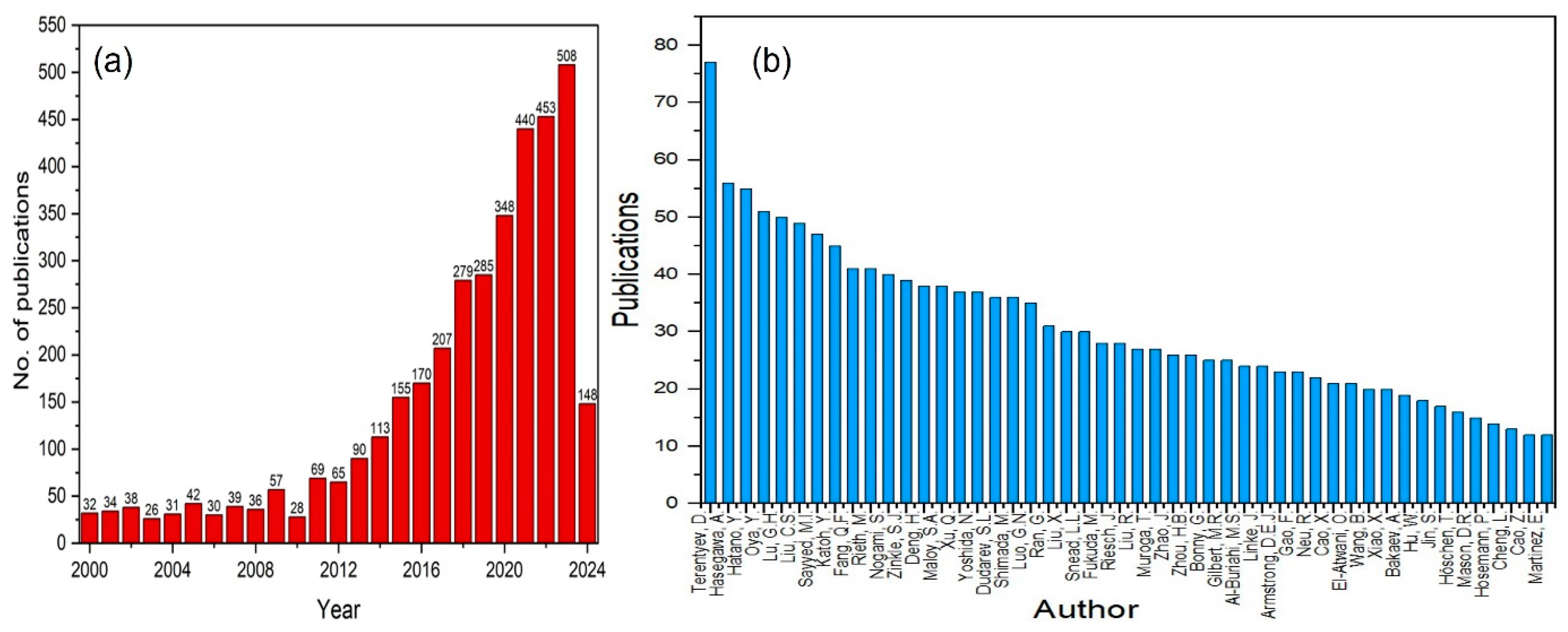

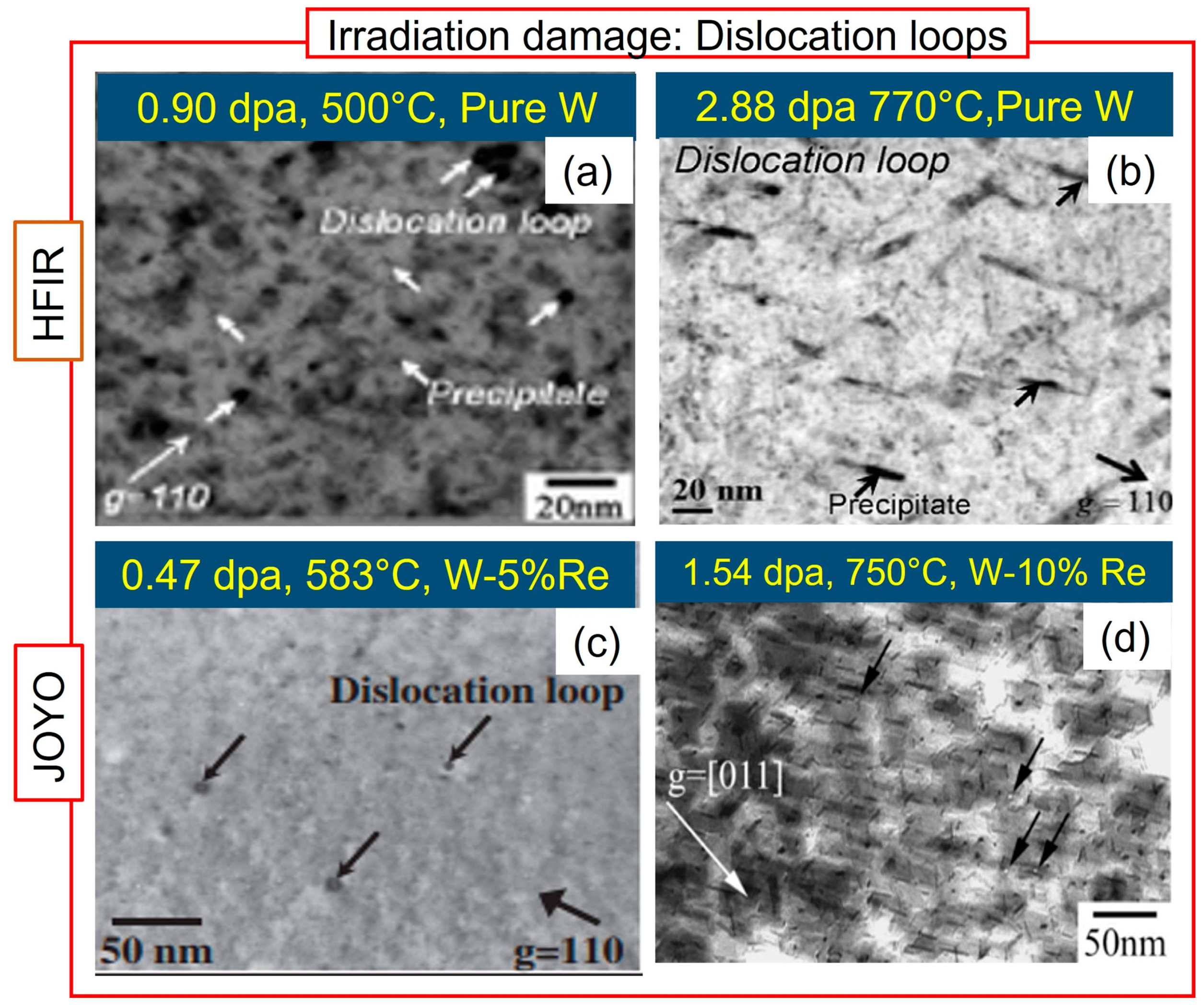
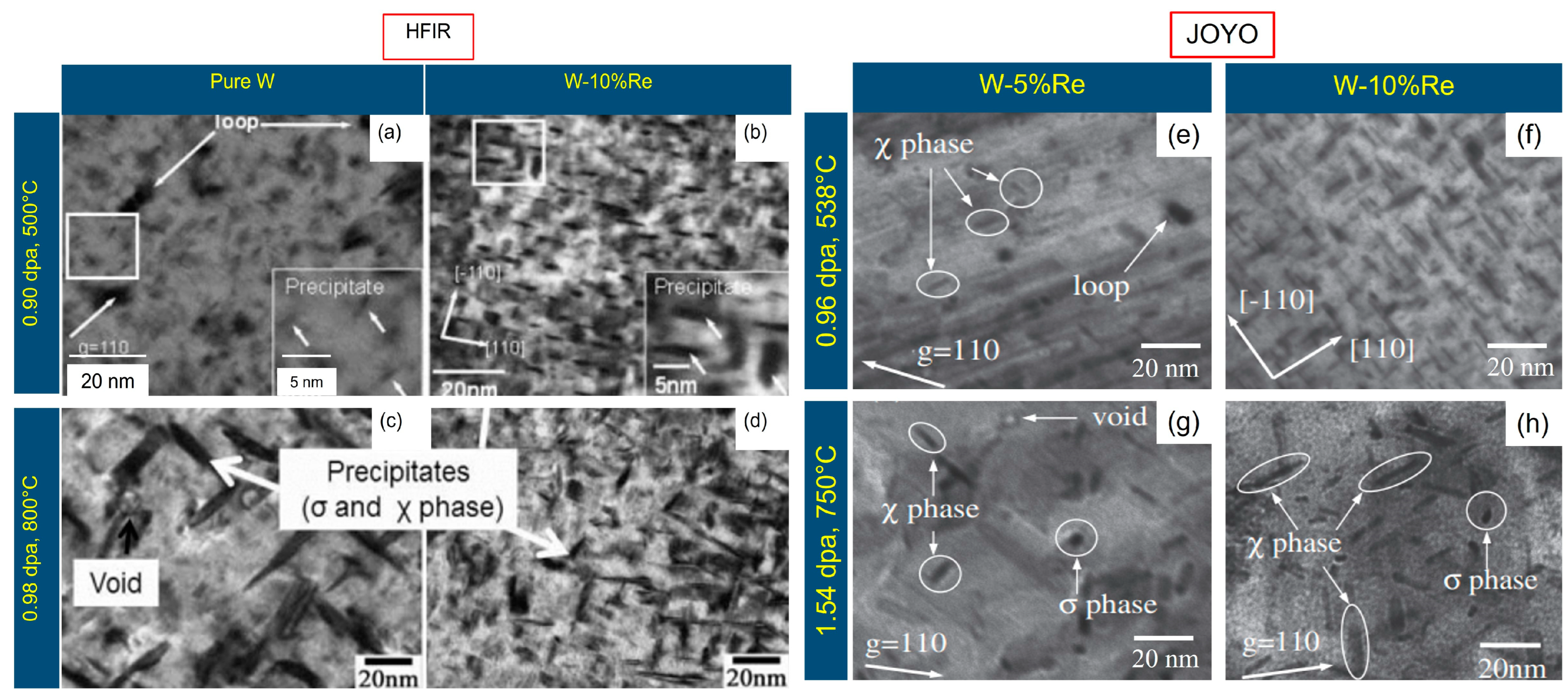

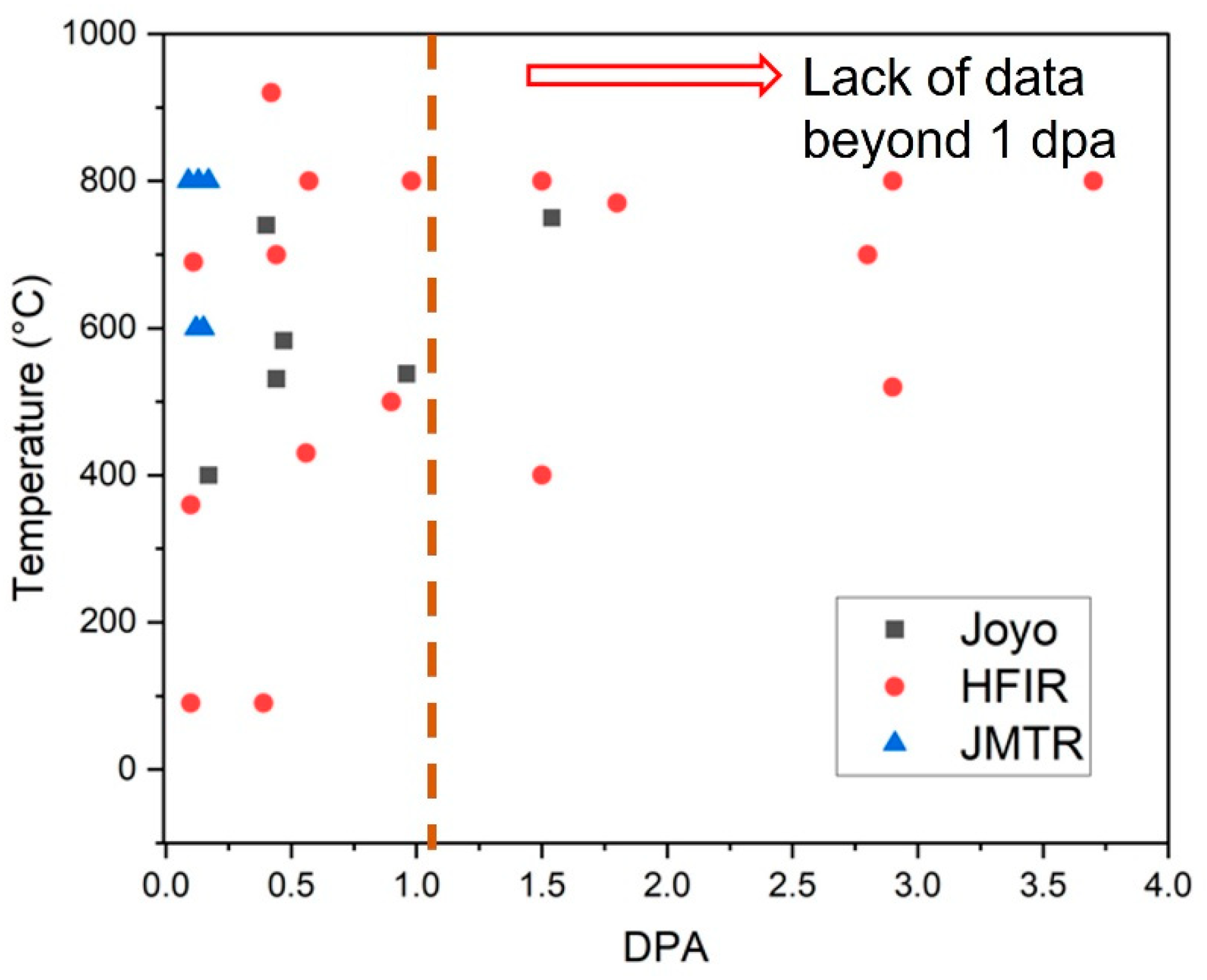

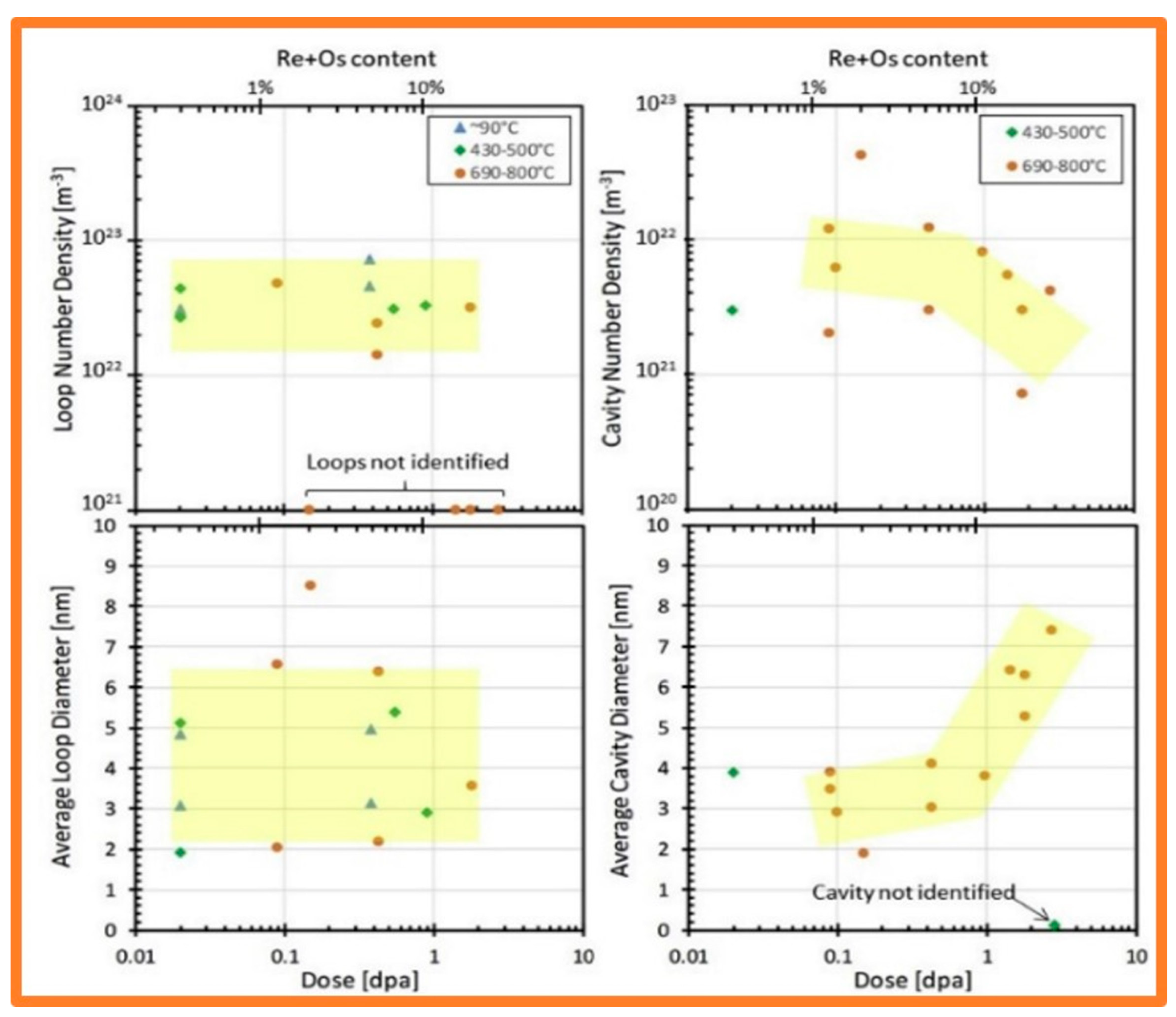
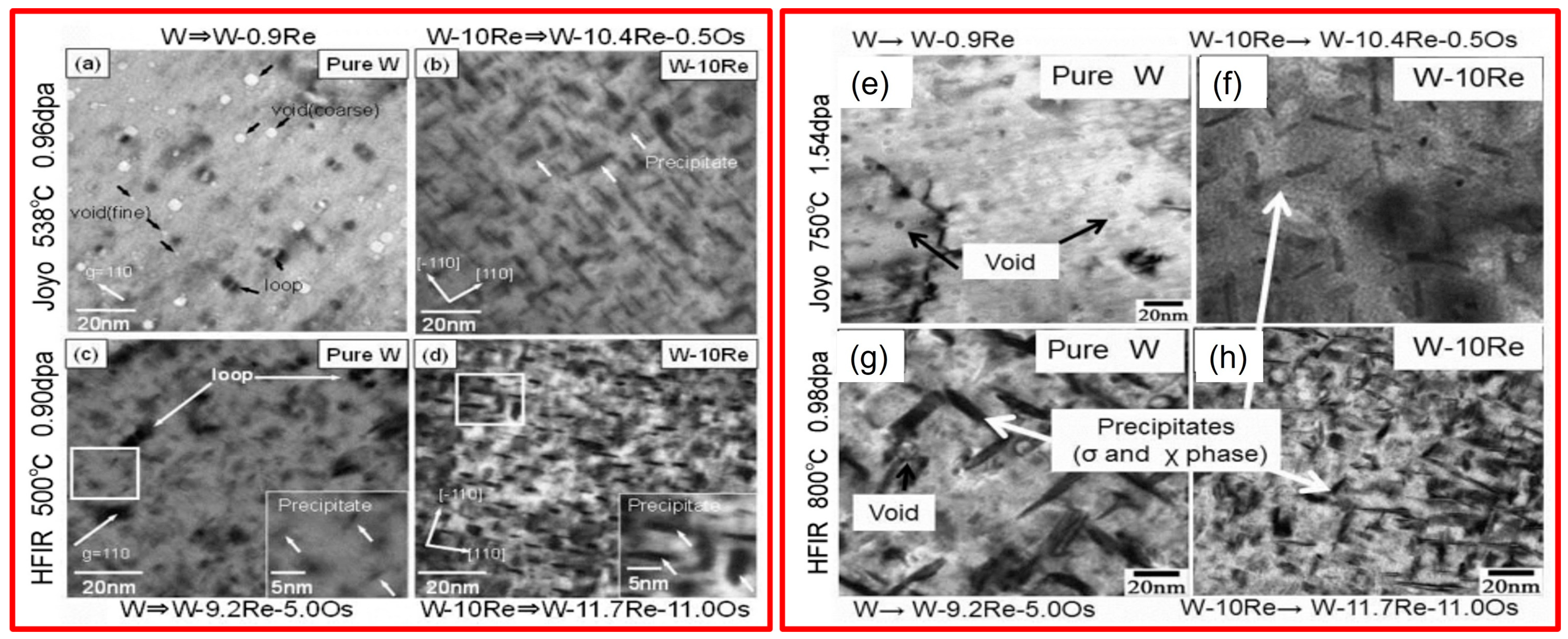

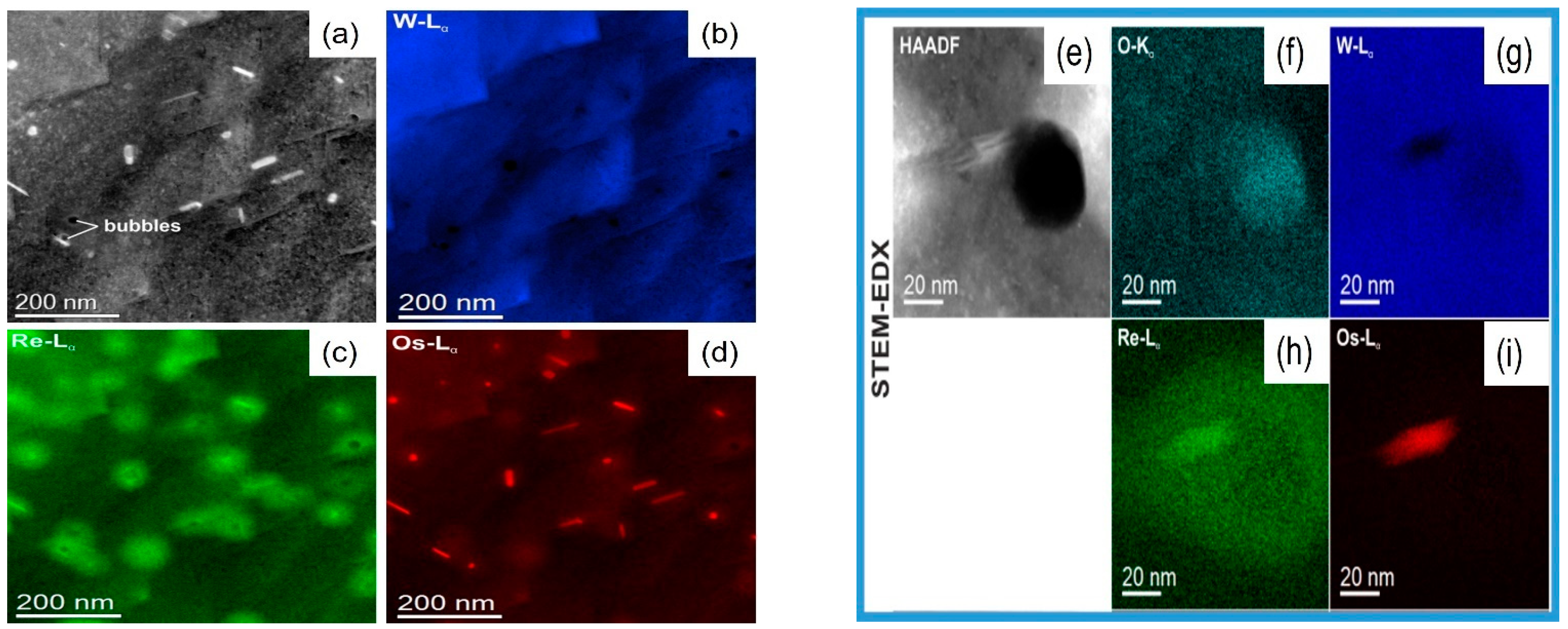
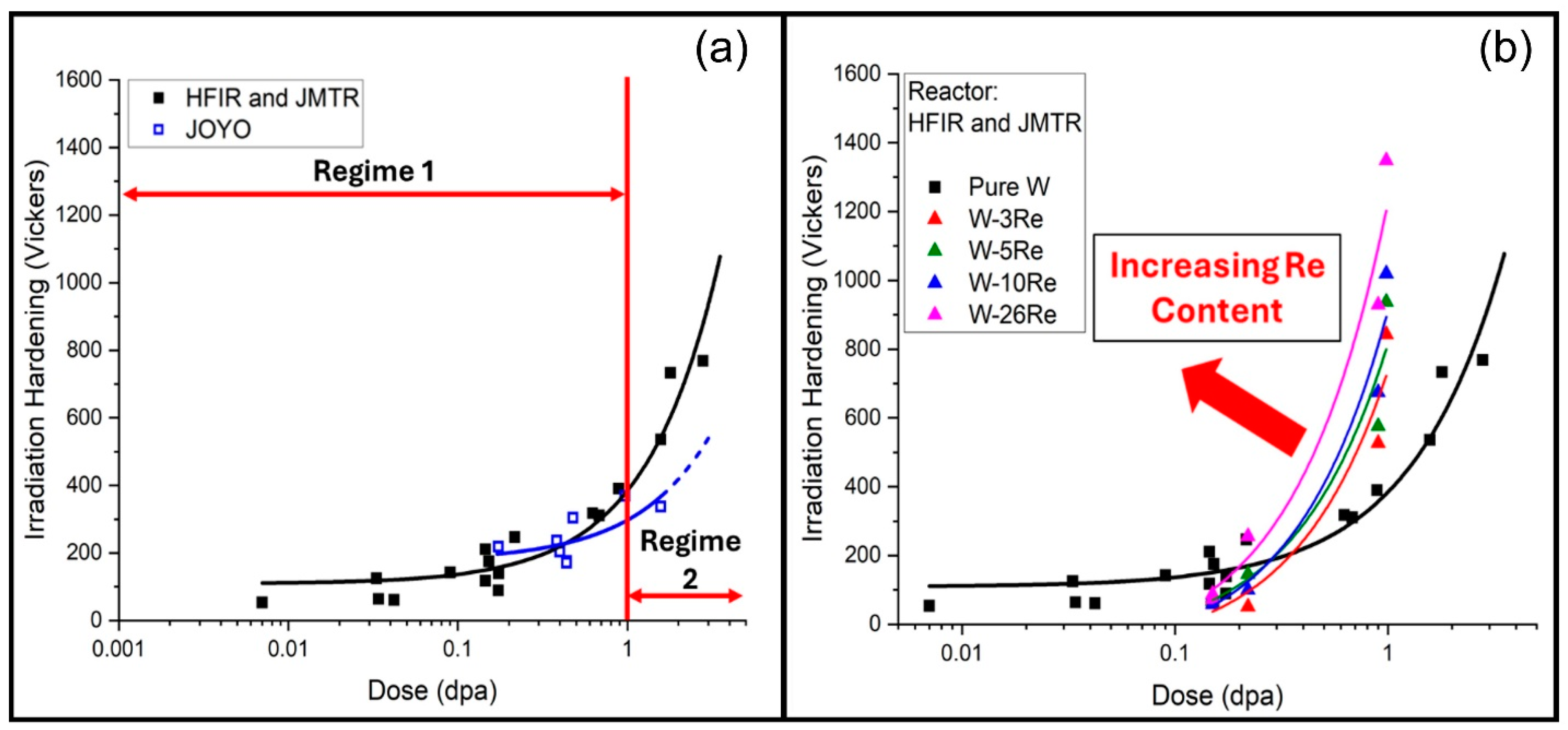
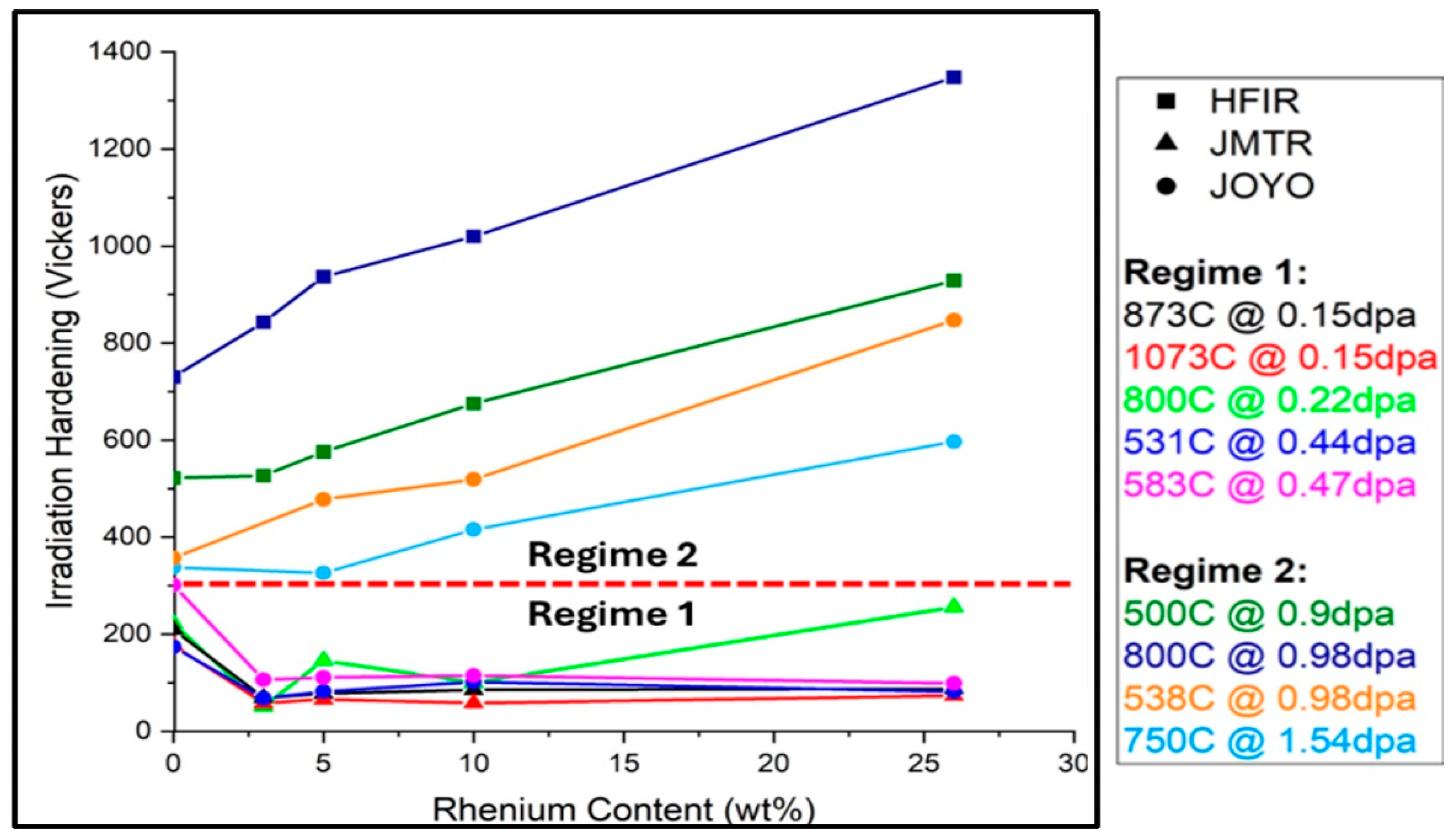
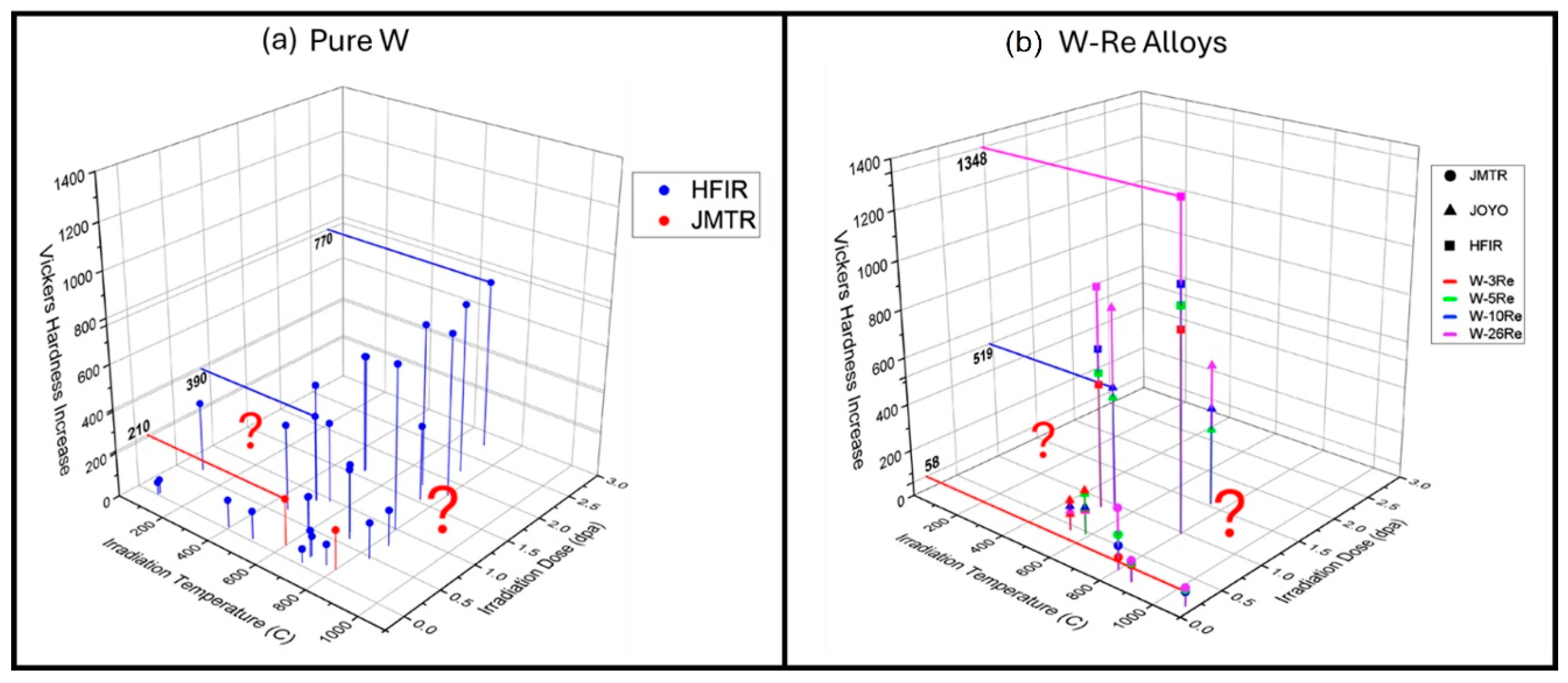
| Defect Density | Pure W | W-Re Alloy |
|---|---|---|
| Void density | 1–5 × 1022/m3 | 0.2 × 1022/m3 |
| High | Low | |
| Dislocation loop density | 1–5 × 1022/m3 | 50 × 1022/m3 |
| Low | High | |
| Precipitate density | 3–10 × 1022/m3 | 10–80 × 1022/m3 |
| Low | High |
| S. No. | Material | Reactor Type | Temp. (°C) | DPA | Dislocation Loop | Void | Precipitate | Ref. | |||
|---|---|---|---|---|---|---|---|---|---|---|---|
| Size (nm) | Density (×1022/m3) | Size (nm) | Density (×1022/m3) | Size (nm) | Density (×1022/m3) | ||||||
| 1 | Pure W | HFIR | 500 | 0.9 | 2.9 | 3 | - | - | 5.7 | 9 | [58] |
| 2 | W-10 Re | HFIR | 500 | 0.9 | - | - | - | 2.2 | 90 | ||
| 3 | W–5%Re | HFIR | 500 | 0.9 | 2.4 | 52 | - | - | 1.9 | 26 | |
| 4 | W–3%Re | HFIR | 800 | 0.98 | - | - | ~1 | 0.01 | 6.8 | 13 | |
| 5 | W–5%Re | HFIR | 800 | 0.98 | - | - | ~1 | 0.01 | 6.6 | 32 | |
| 6 | Pure W | HFIR | 800 | 0.15 | 2 | 4.8 | 3.9 | 0.2 | - | - | [48] |
| 7 | Pure W | HFIR | 710 | 0.7 | 2.2 | 2.4 | 4.1 | 0.3 | - | - | |
| 8 | Pure W | HFIR | 430 | 0.9 | 5.4 | 3.1 | - | - | - | - | |
| 9 | Pure W | HFIR | 770 | 2.88 | 3.6 | 3.2 | 6.3 | 0.3 | - | - | |
| 10 | Pure W | HFIR | 397 | 0.03 | 5.12 | 2.7 | - | - | - | - | [77] |
| 11 | Pure W | HFIR | 467 | 0.6 | 5.38 | 3.1 | - | - | - | - | |
| 12 | Pure W | HFIR | 724 | 0.6 | 6.37 | <0.01 | 3.03 | 1.22 | - | - | |
| 13 | Pure W | HFIR | 742 | 2.2 | - | - | 5.28 | 0.07 | 20 | 4.8 | |
| 14 | Pure W | HFIR | 764 | 0.15 | 6.56 | <0.01 | 3.49 | 0.5 | |||
| 15 | Pure W | HFIR | 500 | 1.62 | 2.9 | 3.3 | - | - | 5.7 | 8.6 | |
| 16 | Pure W | HFIR | 800 | 1.77 | - | - | 3.8 | 0.8 | 16.3 | 3.6 | |
| 17 | Pure W | JOYO | 538 | 0.96 | 4.7 | 5 | 2.1 | 49 | [35] | ||
| 18 | W-10 Re | JOYO | 538 | 0.96 | ~5 | <2 | - | - | 6.8 | 84 | |
| 19 | Pure W | JOYO | 531 | 0.44 | 7.5 | 1.3 | 1.1 | 19 | - | - | [59] |
| 20 | W–3%Re | JOYO | 531 | 0.44 | 3.7 | 4.6 | 1.4 | 0.03 | - | - | |
| 21 | W–5%Re | JOYO | 531 | 0.44 | 2.9 | 1.4 | 1.7 | 0.2 | - | - | |
| 22 | W-10 Re | JOYO | 531 | 0.44 | 7.1 | 0.3 | 3.4 | 0.1 | - | - | |
| 23 | Pure W | JOYO | 583 | 0.47 | ~3 | <0.2 | 3.1 | 12.8 | - | - | |
| 24 | W–3%Re | JOYO | 583 | 0.47 | 2.1 | 1.2 | 1.9 | 0.2 | - | - | |
| 25 | W–5%Re | JOYO | 583 | 0.47 | 2.2 | 1.3 | 1.6 | 0.3 | - | - | |
| 26 | W-10 Re | JOYO | 583 | 0.47 | 4.5 | 0.6 | 3.9 | 0.05 | - | - | |
| 27 | W-26% Re | JOYO | 583 | 0.47 | - | - | - | - | 2.8 | 3.9 | |
| 28 | Pure W | JOYO | 400 | 0.17 | - | - | - | - | - | - | [35] |
| 29 | Pure W | JOYO | 740 | 0.4 | - | - | - | - | - | - | |
| 30 | Pure W | JOYO | 750 | 1.54 | - | - | - | - | - | - | |
| 31 | Pure W | JOYO | 750 | 1.54 | - | - | 4.7 | 12 | - | - | [78] |
| 32 | W-5%Re | JOYO | 750 | 1.54 | - | - | 3.3 | 0.65 | 14 | 7.3 | |
| 33 | W-10 Re | JOYO | 750 | 1.54 | - | - | 1.6 | 3.1 | 9.5 | 42 | |
| 34 | W-3Os | JOYO | 750 | 1.54 | - | - | - | - | 7.3 | 22 | |
| 35 | W-5Re-3Os | JOYO | 750 | 1.54 | - | - | - | - | 6.8 | 67 | |
| 36 | Pure W | JOYO | 756 | 0.42 | 5.6 | 0.1 | 2.5 | 12.1 | - | - | [48] |
| 37 | Pure W | JOYO | 538 | 0.96 | 4.7 | 4.7 | 2.1 | 49 | - | - | |
| 38 | Pure W | JOYO | 400 | 0.17 | 2.8 | 2.0 | 1.8 | 19.5 | - | - | [49,59] |
| 39 | Pure W | JOYO | 531 | 0.44 | 5.4 | 1.1 | 1.3 | 25.3 | - | - | |
| 40 | Pure W | JOYO | 538 | 0.96 | 4.7 | 4.7 | 2.1 | 49 | - | - | |
| 41 | Pure W | JOYO | 583 | 0.47 | 5.4 | 0.2 | 2.4 | 13.8 | - | - | |
| 42 | Pure W | JOYO | 740 | 0.4 | 12.2 | 0.3 | 2.9 | 13.8 | - | - | |
| 43 | Pure W | JOYO | 750 | 1.54 | - | - | 4.7 | 12 | - | - | |
| 44 | Pure W | JOYO | 756 | 0.42 | 5.6 | 0.1 | 2.5 | 12.1 | - | - | |
| 45 | Pure W | JMTR | 600 | 0.15 | 7.9 (rad.) | 0.46 | 1.3 (rad.) | 6.4 | - | - | [47] |
| 46 | W–3%Re | JMTR | 600 | 0.15 | 3.6 (rad.) | 0.14 | 1.1 (rad.) | 3.4 | - | - | |
| 47 | W–5%Re | JMTR | 600 | 0.15 | 3.2 (rad.) | 0.15 | 1.2 (rad.) | 2.1 | - | - | |
| 48 | Pure W | JMTR | 800 | 0.15 | 8.5 | 0.1 | 1.9 | 4.2 | - | - | [48] |
| 49 | Pure W | JMTR | 600 | 0.15 | 7.9 | 4.6 | 1.3 | 6.4 | - | - | [36,79] |
| 50 | Pure W | JMTR | 800 | 0.15 | 8.5 | 1.1 | 1.9 | 4.2 | - | - | |
Disclaimer/Publisher’s Note: The statements, opinions and data contained in all publications are solely those of the individual author(s) and contributor(s) and not of MDPI and/or the editor(s). MDPI and/or the editor(s) disclaim responsibility for any injury to people or property resulting from any ideas, methods, instructions or products referred to in the content. |
© 2024 by the authors. Licensee MDPI, Basel, Switzerland. This article is an open access article distributed under the terms and conditions of the Creative Commons Attribution (CC BY) license (https://creativecommons.org/licenses/by/4.0/).
Share and Cite
Wazeer, A.; McElroy, T.; Stegman, B.T.; Shang, A.; Zhang, Y.; Singh, V.; Li, H.; Shang, Z.; Wang, H.; Xue, Y.; et al. A Brief Review of the Impact of Neutron Irradiation Damage in Tungsten and Its Alloys. Metals 2024, 14, 1374. https://doi.org/10.3390/met14121374
Wazeer A, McElroy T, Stegman BT, Shang A, Zhang Y, Singh V, Li H, Shang Z, Wang H, Xue Y, et al. A Brief Review of the Impact of Neutron Irradiation Damage in Tungsten and Its Alloys. Metals. 2024; 14(12):1374. https://doi.org/10.3390/met14121374
Chicago/Turabian StyleWazeer, Adil, Tanner McElroy, Benjamin Thomas Stegman, Anyu Shang, Yifan Zhang, Vaibhav Singh, Huan Li, Zhongxia Shang, Haiyan Wang, Yexiang Xue, and et al. 2024. "A Brief Review of the Impact of Neutron Irradiation Damage in Tungsten and Its Alloys" Metals 14, no. 12: 1374. https://doi.org/10.3390/met14121374
APA StyleWazeer, A., McElroy, T., Stegman, B. T., Shang, A., Zhang, Y., Singh, V., Li, H., Shang, Z., Wang, H., Xue, Y., Lin, G., Graening, T., Yu, X.-Y., & Zhang, X. (2024). A Brief Review of the Impact of Neutron Irradiation Damage in Tungsten and Its Alloys. Metals, 14(12), 1374. https://doi.org/10.3390/met14121374










